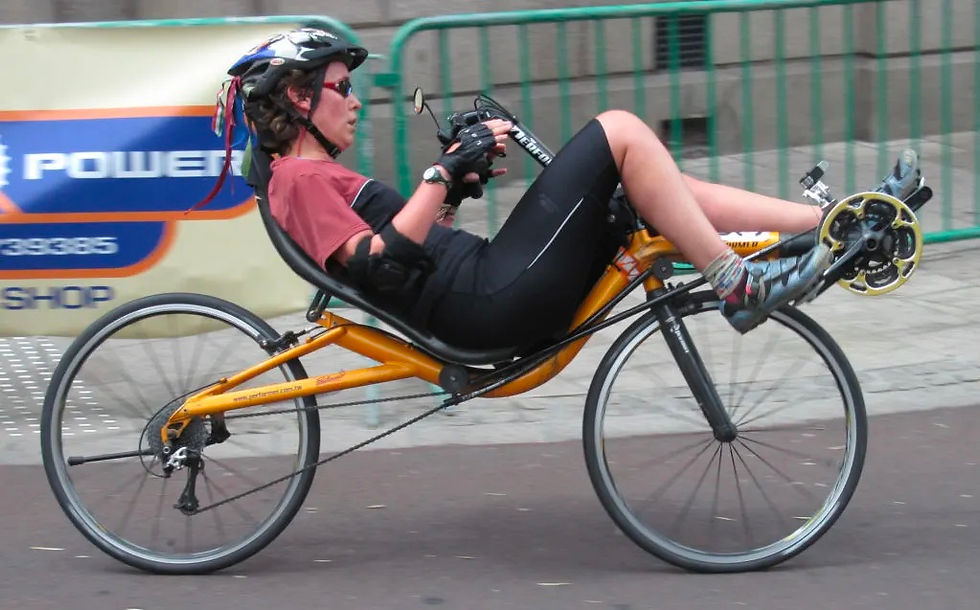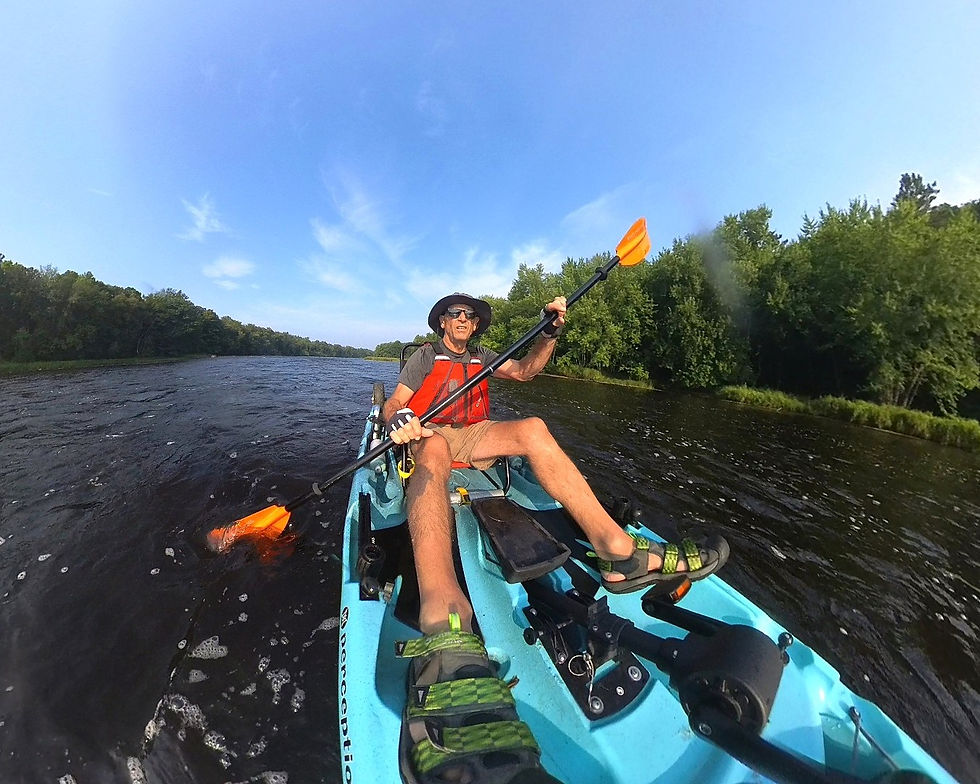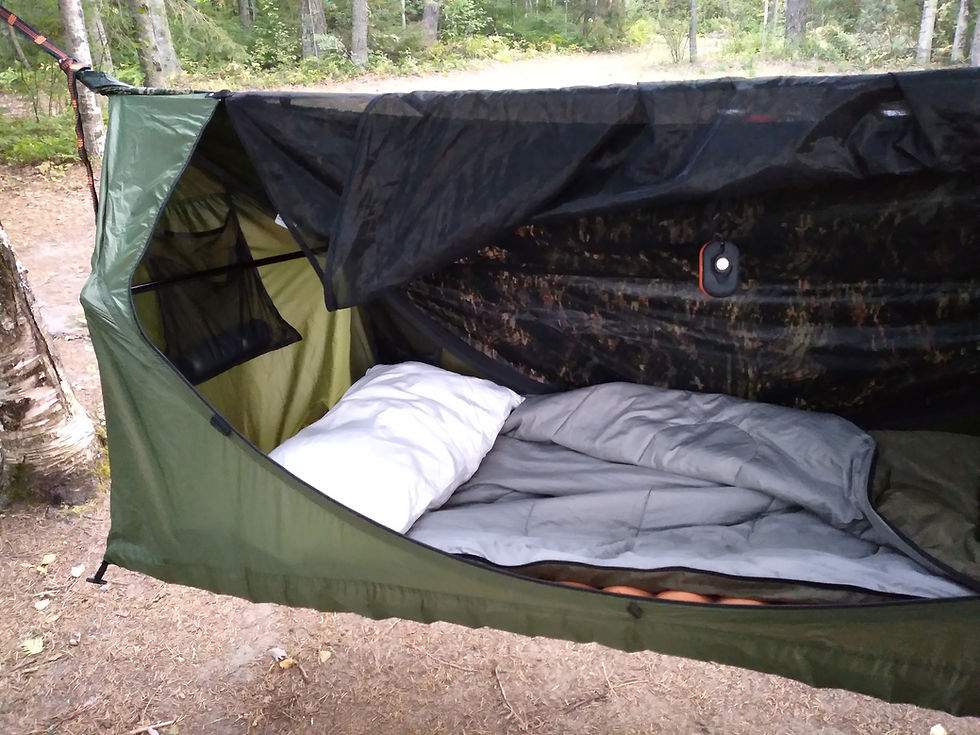Kayak Hammock Camping | Upper Wisconsin River Float Trip with PEDAL Kayak!
- Randy Reek, The Great Out There

- Aug 18
- 8 min read
Can a PEDAL kayak be a great CAMPING and RIVER touring alternative to canoes and sit-in kayaks? YES!
This past Spring I purchased the Perception Showdown pedal-drive fishing kayak. It was on sale during the cold preseason here in Wisconsin and I purchased it for about HALF the price of competitive brands!
I wanted a PEDAL kayak for several reasons:
I am an avid cyclist - with tens of thousands of miles logged on mountain bikes, touring bikes, fat bikes, and gravel bikes. I am not just a bike rider, but I have completed many overnight trips with each of these bicycle types. Pedaling is both my preferred method of travel and exercise.
I have also owned dozens of canoes and kayaks over the years. Like bike touring, I have enjoyed many extended canoe trips of up to a week on lakes and rivers. A pedal kayak has the obvious advantage of massive leg power over arm strength.
I have owned over a dozen motor boats (from 5 to 250 horsepower) and several electric motorized kayaks. After more than 40 years of ownership, maintenance, and storage I have simply grown tired of the expenses and complexities. There is nothing easier than sliding a kayak into the bed of my pickup (with the addition of the MaxxHaul "bed extender") and heading out to the lake!

But the sale price wasn't the primary reason for choosing the Perception Showdown over models from other brands or pedal kayaks. The Showdown also has some unique features which I prioritized for a kayak intended for the occasional camping trip.
While equipped with the Pilot pedal drive, the showdown shares the same hull design as the Perception Outlaw PADDLE kayak. The 36-inch width and square stern add incredible stability and a massive 450-pound total weight capacity. Neither is going to win any races, but the pronounced V-keel at the bow and the flare at the gunnels slice through waves. The notch directly behind this bow keel provides for protected mounting the transducer for my Garmin Striker 4 through the hull.

The transducer for my Garmin Striker 4 locator. The wire runs up through the scupper. At 85-pounds, the Showdown is far from a lightweight. But compared to other pedal kayaks that weigh up to 120-pounds, it is manageable - especially when I add the folding kayak cart for loading and unloading.

I can easily load and unload the Showdown with the folding kayak cart. The Showdown is not too big, and not too small! At 11.5-feet it is long enough to track well, yet maneuverable when fishing or floating downstream. Like all sit-on-top fishing kayaks, the Showdown has scuppers for self-bailing any water that you take on. These scuppers are also provided in the ample bow and stern storage wells, so fishing and camping gear are never going to be floating in water. When fishing on lakes, I enclose the 10 Ah lithium battery for my Garmin locator inside the included bow storage pod.

The Showdown is loaded with features that make it a great fishing kayak. But what makes it a DOUBLE value as a camping kayak?
After the shape, cargo capacity, and stability of the Showdown, the deciding factor in my selection as a dual-purpose CAMPING kayak was the Pilot pedal propeller drive.
The "trendy" kayaks have fin drives. The advertising claims that these fins are super-efficient. But fin drives were NOT my choice for this fishing and touring kayak.
In the first place, ONLY a pedal drive has "instant reverse". You simply pedal forward to move forward; pedal backwards to stop forward progress or reverse. Some fin drives can be reversed with a series of levers, while others need to be removed and reinstalled "backwards", the removed again to resume forward motion.
Secondly, the Pilot drive on the Showdown is designed to fold up in shallow water or around rocks. The drive is completely flush with the hull of the kayak. Other drives require you to fully remove the drive when not in use. I can paddle through whitewater rapids, drag the kayak through shallow riffles, or portage the kayak around dams without removing the prop drive. The Pilot drive folds up and forward and is not in the way for paddling. I can switch back between pedaling and paddling easily on the water.
Most fin drives fold relatively flat against the bottom of the hull for beaching the kayak. But I would never trust these folded fins in a rock garden or shallow shoal. Completely removing the fin drive would be an aggravating pain and require a stop along the shoreline to tie it down!
Finally, the Pilot propeller drive uses gearing to maximize your pedaling motion. With a fin drive, each push of the pedals produces one "flap" of the fins. Just like adding swim fins, each kick has greater force.
But the propeller on the Showdown is driven through a gear in the lower unit, exactly like an outboard motor. ONE full rotation of the cranks on the top side turns the prop SIX times under water!
I find that I am comfortably pedaling about 50 RPMs - FAR slower than when I am riding my bicycle. But this easy, sustainable pace whirls the prop at 300 RPMs below the surface!
The first time I switched from paddling to pedaling I estimated an increase in efficiency of at least FOUR times! This makes sense when you compare the huge strength advantage of your legs over your arms.
As mentioned earlier, the Showdown, like its twin the Perception Outlaw, CAN be paddled. But I didn't buy the Showdown for paddling across the lake - I will PEDAL in water over 18-inches deep. I will ALWAYS carry a backup paddle, and break out the paddle for use close to shore. But the pedal drive allows me to cruise to my fishing location, and hold my position by feathering the prop forward and backward, as needed.
Pedaling is also faster. When paddling, you rely on a short glide between strokes as the boat slows. The same is true with fin drives. When pedaling, the motion is more consistent and the forward progress smoother. As in all human-powered sports, Smooth is Fast!
This was my motivation when selecting a pedal kayak that would be occasionally called on to carry me on extended camping trips.
I wanted a kayak that was capable of carrying me and my gear. The 450-pound gross capacity of the Showdown provides at least a 200-pound safety margin.
I wanted the mechanical advantage of the prop drive to travel farther with far less effort than paddling. I wanted the most efficient drive system, and a drive that was mechanically robust for insurance on remote trips.
The sit on kayak sheds water from waves and climbing in and out. I never need to bail water. I can wash out mud, bugs, and fish slime by splashing water into the kayak. While I still pack my gear in dry bags, I don't worry about any seepage from floating in bilge water.
The Showdown is long enough for straight tracking on lakes, but short enough for paddling through easy rapids - the limit of my present ambitions.
The only disadvantage of the Showdown is the weight. As discussed, I rely on the kayak cart for loading and unloading. In years past, I prided myself on completing long, rough portages with tandem canoes. Now, I limit my adventures to open lakes or routes with easy portages that I can negotiate with the kayak cart - which loads on top of my camping gear!

My kayaking day trips and overnight camping trips involve fishing! There were a few additional modifications that I made to the Showdown to customize it to my tastes for fishing.
The Showdown has plenty of accessory mounting options. I added two 1-inch RAM mounts on either side of the pedal drive for the locator and camera mounts. (These threaded mounts are an exclusive feature of Perception kayaks.) I installed two more mounts for rod holders on the center tracks. And I added two heavy duty 1.5" RAM ball bases on the rear side panels - attached with threaded inserts into the thick plastic body. These heavy bases are for trolling rods, lights for night fishing, and camera mounts.

I installed an anchor trolley along the port side for better control when fishing a tight structure. Just a light anchor is all you need to control a shallow draft kayak when fishing. Make sure that your anchor can be disconnected quickly if it gets stuck in the rocks, especially with any current. My kayak anchor has a buoy in case I need to disconnect it and go back upstream to dislodge it. I secure the rope to the top eyelet with a breakable zip tie to make retrieving easier. I also added a 2-foot length of plastic coated chain for better contact wit the bottom.
Lastly, I removed the stock, raised seat platform. In my opinion, this elevated seat is marketed to bass fishermen in calm backwaters. I fish big, windswept lakes! I also run whitewater rapids and I prefer a lower center of gravity.
Of course, the raised seat also makes the seating position adjustable for a range of users. I didn't care about this - once I had the seat in the right position (relative to the pedals), it was not going to move!
My first substitution was a basic low beach chair, designed as an option for paddle boards. This fit perfectly and I added a few tie downs and a Velcro retaining strap to prevent movement when pushing against the pedals - and to secure the chair during transport.
While this chair worked well, the lack of padding and lower back support made me look for more comfortable alternatives. I settled on a raised kayak seat from Bass Pro branded for their Ascend kayaks.
This seat also mounts flat on the deck of the Showdown for maximum stability. I have long legs, so the seat is mounted back from the pedals. for this model seat I was able to install an aluminum angle that bridges the stock tracks. Now, if I ever need to adjust the distance to the pedals, it is easily accomplished.

Some owners will still prefer the raised seat. However, you lose some force pedaling at a diagonal. Compare the seating position to recumbent bicycles - which have set all the speed records unmatched by conventional bikes and were banned by the Union Cycliste Internationale (UCI) in 1934! Recumbent bikes feature a reclined seat with back support, which distributes weight more evenly and reduces pressure on the back, neck, and wrists. This allows for a more comfortable ride, particularly during longer cycling sessions.
Kayak pedalers should learn from a century of recumbent technology!!!
Here are the highlights from my recent 50-mile float trip down the upper Wisconsin River, including several rapids, and two nights of hammock camping in the Perception Showdown. The Wisconsin River is known as "the hardest working river in the world because of the numerous dams that provide hydro power for municipalities and the paper industry. This float trip includes portages around four dams.
Please leave your comments below. Have you taken your pedal-drive fishing kayak on overnight camping trips? Have you always wanted to? I will be following this article with some specific tips for camping from a pedal kayak. Please subscribe to the GreatOutThere.online blog for updates. And follow me also on Facebook, YouTube, Instagram, and Pinterest!













Comments